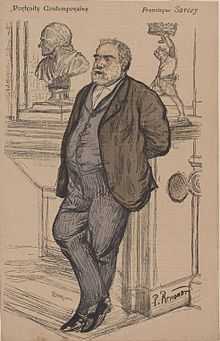Francisque Sarcey


Francisque Sarcey (8 October 1827 – 16 May 1899) was a French journalist and dramatic critic.
He was born in Dourdan, Essonne. After some years as schoolmaster, a job for which his temperament was ill-fitted, he entered journalism in 1858. He contributed to Le Figaro, L'Illustration, Le Gaulois, Le XIX' Siècle and other periodicals; but his main interest was dramatic criticism, of which he had his first experience in L'Opinion nationale in 1859. In 1867 he began to contribute to Le Temps the "feuilleton" with which his name was associated till his death. His position as dictator of dramatic criticism was unique. He had the secret of taking the public into his confidence, and his pronouncements upon new plays were accepted as final.
He was a masterly judge of acting and of stage effect; his views as to the drama itself were narrow and indifferent to artistic progress. For example, in 1896, he reviewed the premiere of Alfred Jarry's play Ubu Roi—a precursor of the Theatre of the Absurd—and called it "a filthy fraud which deserves nothing but the silence of contempt." Such opinions made him a subject of ridicule among the rebellious young artists and writers of Montmartre. Between 1886 to 1893, the writer and humorist Alphonse Allais published a notorious series of newspaper columns under Sarcey's name with titles such as "How I Became an Idiot."
Sarcey published several miscellaneous works, of which the most interesting are Le Siege de Paris, an account compiled from his diary (1871), Comédiens et comediennes (1878-1884), Souvenirs de jeunesse (1884) and Souvenirs d'âge mur (1892; Eng. trans., 1893). Quarante ans de theatre (1900) is a selection from his dramatic Feuilletons edited by A Brisson. He died in Paris.
Publications in English Translation
- How I Became an Idiot by Francisque Sarcey (Alphonse Allais) Translated by Doug Skinner (Black Scat Books: Absurdist Texts & Documents - Interim Edition No. 00, 2013)
References
 This article incorporates text from a publication now in the public domain: Chisholm, Hugh, ed. (1911). Encyclopædia Britannica (11th ed.). Cambridge University Press
This article incorporates text from a publication now in the public domain: Chisholm, Hugh, ed. (1911). Encyclopædia Britannica (11th ed.). Cambridge University Press
|